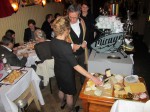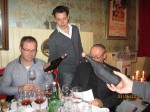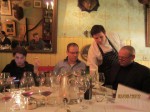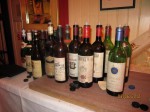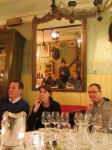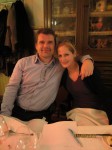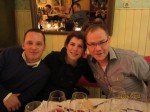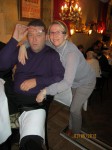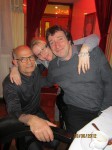Te oud is misschien niet alles, 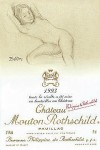
maar te jong zeer zeker niet goed ….
Enige tijd geleden gaf ik al mijn schriftelijke reactie
http://www.fred-nijhuis.nl/2012/01/ouwe-meuk-of-oude-meesters/ op de, in mijn ogen, onterechte, kortzichtige zienswijze van iemand die graag wil dat we wijn (te) jong drinken. Too old may not be everything,
But too young is certainly wrong…..
Some time ago, I already shared my written response to the, in my opinion, unfair, short-sighted point of view of someone who wants us to drink wine (too) young.
see: http://www.fred-nijhuis.nl/2012/01/ouwe-meuk-of-oude-meesters/?lang=en
Hierbij de resultaten van een avond met oude wijnen tijdens een geweldige avond in restaurant de Opera te Den Bosch waar chef
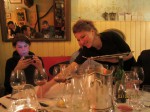 Harrie Hendriks en gastvrouw Anne Engel voor de juiste ambiance zorgden om de (meeste) wijnen te laten excelleren. Het bleek een leerzame avond met wijnen die verrasten en respect afdwongen.
Harrie Hendriks en gastvrouw Anne Engel voor de juiste ambiance zorgden om de (meeste) wijnen te laten excelleren. Het bleek een leerzame avond met wijnen die verrasten en respect afdwongen.
Met speciale dank aan Ron Andes MV 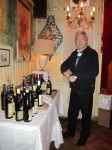 die de meeste
die de meeste
wijnen inbracht, Jan Ronald Boering die een drietal fraaie aanvullingen meenam, Matthijs Vranken die voor de enige witte wijn zorgde, Natascha Sonnemans die ‘haar’ 1972 Il Poggio van Castello di Monsanto ‘opofferde’ en Nitiya die weer heel wat sfeerplaatjes schoot.
De wijnen:
 Arnold Brösch, St. Margarethener Rust Spätlese,1977
Arnold Brösch, St. Margarethener Rust Spätlese,1977 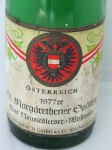
Donkergeel van kleur; in de mooi ontwikkelde geur veel gedroogde bloemen en fruit, waaronder rozijnen, lichte oxidatieve toon; vol van smaak, ingetogen zoet, impressies van sinaasappel en limoen, goede balans, lange afdronk met frisse zuren, fraaie wijn met interessant spel tussen fruit, zuren, zoet en ontwikkelde aroma’s. Met dank aan Matthijs Vranken.
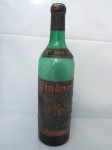 Lindner, Eppaner Justiner Auslese, 1966
Lindner, Eppaner Justiner Auslese, 1966
Donkerbruin van kleur, laurier en andere kruiden in de neus en aroma’s die doen denken aan een droge oloroso, vluchtige zuren, strak en droog van smaak, te ver ontwikkeld.
2e fles; vergelijkbare kleur en geur, maar droger.
Rubini, Refosco, 1983 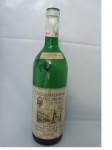
Opvallend frisrode kleur, veel fruit als rozenbottel in de geur naast gedroogde bloemblaadjes, mooi geconcentreerd, levendige zuren, prima balans en nog altijd volop leven, afdronk iets beperkt qua expressie en lengte, beslist niet over zijn top.
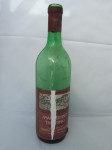 Az. Agr. Simocelli Armando, Marzemino, 1982
Az. Agr. Simocelli Armando, Marzemino, 1982
Bruine gekleurd; in zowel geur als smaak te ver ontwikkeld; helaas.
Tenuta Maseria Florio, Tazzelenghe, Ronchi di Buttrio, 1976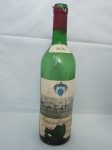
Nauwelijks kleur meer, zeer ver ontwikkeld in zowel kleur, geur als smaak; hoge zuren, allerlei vluchtige tonen; beste tijd gehad.
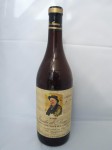 Elvio Cogno, Boschi di Berri (Dolcetto), 1979
Elvio Cogno, Boschi di Berri (Dolcetto), 1979
Rijpe Dolcetto, licht oxidatief, wat houtinvloed, volop impressies van kriek en kirsch, structuur is goed, zuren op de juiste plaats, fruit nog altijd aanwezig, geen enorm lange afdronk, maar schoon en fruitrijk; zeer goed. Compliment aan de druif, zijn terroir en de wijnmaker!
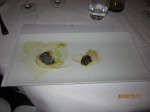
Deed het fantastisch bij de slakjes
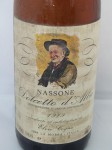 Elvio Cogno, Nassone (Dolcetto), 1973
Elvio Cogno, Nassone (Dolcetto), 1973
Geur lijkt op de Boschi di Berri, maar is veel verder ontwikkeld; overwegend herfstimpressies, gedroogde vlees en gedroogd fruit; ontwikkeld en ver gerijpt, maar genietbaar en blijft toch heel bijzonder, een drinkbare Dolcetto van bijna 40 jaar oud.
Cantina Sociale Riunite, Vino Riserva Oltrepo Antico Piemonte (Bonarda?), 1958 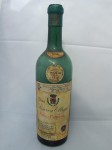
Intens geurend naar karamel, veel laurier, in de mond sherry-achtige tonen, proefbaar maar niet geweldig, drogende tonen en hoge, oude 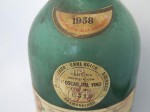 zuren geven de wijn een uitgeblust karakter, niet zo vreemd voor een eenvoudige wijn na ruim 50 jaar….
zuren geven de wijn een uitgeblust karakter, niet zo vreemd voor een eenvoudige wijn na ruim 50 jaar….
Cantine Ercole Giovara, Cerasuolo, Piëmonte, 1964 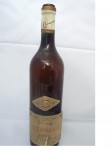
Rosé van Cerasuolo uit Piëmonte van bijna 50 jaar oud! Het kan bijna niet extremer. Fraaie donkerroze kleur, wel wat evolutie, maar heeft nog altijd fruit dat versmolten overkomt met zachte herfsttonen; impressies van gedroogd rood fruit staan overeind en centraal in geur en smaak; mooi droog, evenwichtig en zelfs nog sappig met accenten van gekonfijte aardbeitjes; goed en heel verrassend
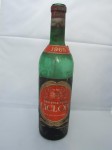 Cantine Sabea, Vino Etna Rosso “Ciclopi” Riserva Duca di Mr Bianco, 1965
Cantine Sabea, Vino Etna Rosso “Ciclopi” Riserva Duca di Mr Bianco, 1965
Koffie en cacao in de neus met oxidatieve tonen, de smaak is dun en de wijn verschraald; helaas.
Caparra & Siciliani, Ciro Riserva, 1963 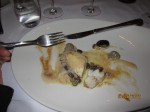
De geur is ontwikkeld, maar rijk; de smaak droog, frisser, beter dan de geur en meer dan correct, subtiel en fragiel, nog levend. Verdient als erg eenvoudige wijn van de veelal onbekende Gaglioppo-druif uit deze ondergewaardeerde streek een moment van bezinning en respect. Het hoeft dus niet allemaal duur en fameus te zijn om van te kunnen genieten.
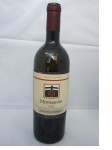 Marchesi Frescobaldi, Mormoreto, 1985
Marchesi Frescobaldi, Mormoreto, 1985
Geur komt oxidatief over, niet helemaal fris meer, veel hout en kruiden, smaak is beter met nog wat donker fruit en sap, impressies van gedroogde kruiden en de nodige tannine; fruit is niet meer in optimale conditie, maar nog altijd proefbaar.
Met dank aan Jan Ronald Boering
Marchesi Frescobaldi, Montesodi, Chianti Rùfina Riserva, 1983 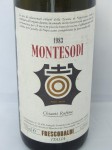
De Montesodi is een wijngaard op circa 400 meter hoogte, aangeplant met Sangiovese. In 1974 werd er voor het eerst een single-vineyard wijn van gemaakt.
Elegante kleur; in de neus ceder, hout en nog altijd fruit, de smaak is opvallend sappig en levendig, goede structuur met rijpe, natuurlijke tannine, mooi zoet fruit en een fraaie balans; evenwichtige edele wijn, mooi ontwikkeld en met behoud van lengte; bewijst de klasse van de Montesodi. Met dank aan Jan Ronald Boering
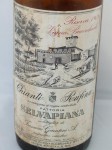 Fattoria Selvapiana, Vigna Bucerchiale, Chianti Rùfina Riserva, 1979
Fattoria Selvapiana, Vigna Bucerchiale, Chianti Rùfina Riserva, 1979
Mooie kleur en geur, versmolten rood fruit, fijn en levendig, minerale tonen, veel kersen en bessen, prachtige zuren, tannine geeft structuur, fraaie balans en spanning, nog duidelijk lengte, overtuigende elegantie, het bewijs dat Rùfina een prachtige terroir heeft en Sangiovese hier kan excelleren.
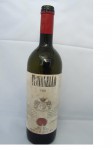 Antinori, Tignanello, Vino da Tavola, 1981
Antinori, Tignanello, Vino da Tavola, 1981
De allereerste keer dat een wijn de naam Tignanello droeg, was het nog een soort nieuwe stijl super-chianti. De 1971 Tignanello was in principe een Chianti Classico, maar dan opgevoed in barriques, van 100% Sangiovese en dus vooral zonder de toen nog de wettelijk verplichte toevoeging van witte druiven. Daarna besloot Piero Antinori om er heel andere wijn van maken om zich nog beter te kunnen onderscheiden en duidelijk te maken wat zijn visie was op de ontwikkeling van de wijnbouw in Toscane. In overleg met meester-oenoloog Giacomo Tachis werd gekozen voor een blend van circa 80 (later 85%) sangiovese met 20% (later 15%) cabernet sauvignon en cabernet franc. Het eerste jaar dat deze wijn kon worden gemaakt, bleek 1975 en een fenomeen was geboren.
De 1981 heeft een ingetogen geur en blijkt een Tignanello op leeftijd; gerijpt, maar in prima conditie met een fraaie balans, sap, wat tannine en hout, maar vooral mooi fruit, een aangename vulling en spanning; elegant met overtuigingskracht; de cabernet is te proeven en vult de finesse van de sangiovese aan met kracht en accenten van donker fruit; fraaie wijn met voldoende potentieel om rustig verder te ontwikkelen. Presenteerde zich als één van de jongste wijnen van de avond.
Met dank aan Jan Ronald Boering
Antinori, Tignanello, Vino da Tavola, 1980 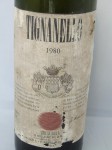
Persoonlijk commentaar van Piero Antinori: 1980 was een goed oogstjaar en misschien wel het beste uit de tachtiger jaren. Het was een lang groeiseizoen door iets koelere weersomstandigheden en dat gaf de wijnen meer elegantie dan kracht. Dat komt ook tot uitdrukking in de 1980 Tignanello. Goede evolutie van de kleur met enig bruin op een rode basis; in de neus wat tabak, drop en gedroogde pruimen, fluwelige tanninestructuur, minerale accenten en een zuurgraad die de wijn elegantie en verfijning geeft. Prima voorbeeld van een Tignanello uit een elegant jaar.
Onze ervaring:
Meer ontwikkeling dan de 1981, meer herfst, truffel en paddenstoelen met gedroogde bloemen, ook kruiden en tabak. In de mond de juiste balans, tannine en droging overheersen niet, subtiele fruittonen, alles fragiel en heel licht. Delicate wijn die aantoont hoe aangenaam 1980 in Toscane was en hoe goed Tignanello is. Een ballerina.
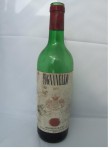 Antinori, Tignanello,Vino da Tavola, 1975
Antinori, Tignanello,Vino da Tavola, 1975
De eerste Tignanello in zijn huidige vorm dus.
Persoonlijk commentaar van Piero Antinori: 1975 was één van de beste jaargangen ooit voor Tignanello, een prachtig seizoen dat de wijn veel structuur en intensiteit heeft gegeven. De wijn is nog altijd levendig met een fraaie kleur, intens met wat bruin; tannine is fluwelig en maakt de wijn lang en zoet.
Wij proefden en kregen de nodige discussie over deze wijn. Het niveau in de fles was ‘mid-shoulder’ en over de geur verschillen de meningen van ‘onzuiver’ tot ‘oud’ en ‘te oud’. Smaak is beter dan de geur, maar alles blijft heel fragiel en de aroma’s van de wijn lossen als het ware op in het glas. Twijfels over de conditie van deze fles overheersen.
Tenuta San Guido, Sassicaia, Vino da Tavola, 1974 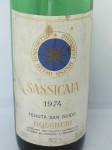
De geur is niet uitgesproken, wel ver ontwikkeld met wat vermoeid tonen en accenten van kaas; de smaak is beter, vol en duidelijk cabernet met zwart fruit en de juiste houtinbreng, mooie zuren en prima structuur; afdronk is rijk aan tannine, goede body met fruit en sap, middellange afdronk, fraaie verrassing, maakt zijn naam en faam waar, ook al is 1974 geen topjaar.
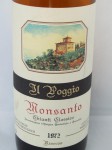 Castello di Monsanto, Il Poggio, Chianti Classico Riserva, 1972
Castello di Monsanto, Il Poggio, Chianti Classico Riserva, 1972
Een bijzondere wijn uit een jaar dat de meeste producenten graag vergeten. Regen domineerde de oogst en resulteerde in veel trieste wijnen. De heuvel Il Poggio werd aangetast door botrytis, maar de druiven bleken verder gezond. Fabrizio Bianchi besloot er toch een wijn van te maken en zag een unieke wijn ontstaan. De botrytis zorgde voor kleurverlies en geur- en smaakcomponenten die hij in geen enkele andere Poggio aantrof. Een intrigerende wijn; door hem vaak omschreven als een afrodisiacum. Geurt naar een witte wijn, impressies van abrikozen, noten, mint en crème; de smaak is goed, eigenzinnig met intrigerende zoete tonen tegenover frisse zuren, heel apart maar in de goede zin van het woord; gemiddelde structuur met eigenzinnig karakter en allesbehalve over de kop. Met dank aan Natascha Sonnemans.
Fattoria di Nozzole, Nozzole, Chianti Classico,1969 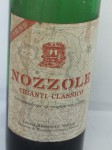
Lichte, transparante kleur en een zachte, elegant geur; fraaie, typische oude Chianti, veel meer potentieel dan bij de meeste mensen (en producenten) bekend is; subtiel, fijntjes, maar blijft goed overeind, gedroogde fruit, florale tonen en prima balans, iets droog, middellange afdronk; edele wijn.
 Paolo Cordero di Montezemolo, Barolo, 1969
Paolo Cordero di Montezemolo, Barolo, 1969
Wisselende beoordelingen. Sommigen vonden de wijn te oud, anderen genoten van de traditionele kleur, geur en smaak van gerijpte Nebbiolo met impressies van teer, rozen, zuren geven spanning en tannine die nog heel voelbaar is; de nodige droging en hoge zuren in de finale.
Travaglini Giancarlo, Gattinara, Selezione Numerata, 1968 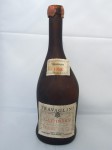
Ontwikkelde aroma’s maar beduidend frisser dan de Barolo uit 1969; mineralen en veel fruit, gedroogde rode vruchten, rozen, drop, hint van teer, typisch Nebbiolo; heel zuiver en elegant, zoet middenrif, gedroogd rood fruit, wat witte peper, tannine aanwezig maar gedoseerd en ondersteund door fruit; zeer fraai in alle opzichten.
 Scarzello Giorgio F.lli, Barolo, 1965
Scarzello Giorgio F.lli, Barolo, 1965
Roze kleur, zeer licht, belegen geur met accenten van rozen, zacht van smaak en drinkbaar met rinse zuren, maar wel heel ver ontwikkeld, afdronk is kort en wordt gedomineerd door bitters, wijn blijft enige tijd in balans, maar valt uiteen bij langer openstaan; niet groots en na ruim 45 jaar (!) over zijn hoogtepunt heen, maar beslist genietbaar.
F.lli Cavallotto, Barolo Riserva, 1964 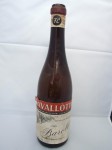
Fraaie afgeronde geur, opvallend fris en levendig, beduidend jeugdiger dan de Scarzello uit 1965; mooie delicate wijn met tonen van specerijen, herfst en rood fruit; prima balans en voldoende grip en smaak; klein bittertje in de afdronk waarin ook florale tonen (gedroogde rozen) naar voren komen; aangename, zachte, ontwikkelde wijn; zeer goed.
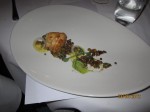
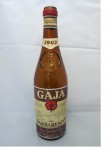
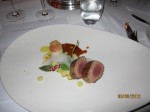
Gaja, Barbaresco, 1962
Duidelijk geëvolueerd, maar de geur staat nog overeind, nog altijd de typiciteit van Nebbiolo met voldoende rood fruit, wat teer, leder en florale tonen; de smaak is even elegant als vol, veel evolutie, maar nog in goede conditie, tannine en warme gloed van alcohol in de afdronk; netjes.
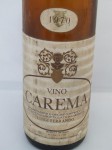 Luigi Ferrardo, Carema, 1970
Luigi Ferrardo, Carema, 1970
Mooie rode kleur, geur bevat nog jeugdige tonen, smaak is vol met prachtig zoet rijp fruit en florale accenten, een mooie balans, fris en spannend met veel concentratie, de lange afdronk belooft veel, zeer complete wijn met nog meer toekomst, presenteert zich als een charmeur; zeer fraai.
Luigi Ferrardo, Carema, 1957 
Veel ontwikkeling in kleur en geur; licht rood met een bruine gloed maar met een goede intensiteit; in de neus eerst terughoudend, heeft lucht nodig en geeft dan een mooi geurpalet met rozen, noten, kruiden als laurier en kruidnagel met peperige accenten; in de mond is de wijn zacht en vol, met zoet fruit, malse tannine en zuren die relatief jeugdig overkomen; de wijn groeit in het glas en toont pas na een kwartier zijn volledige kracht, complexiteit en finesse; subtiele tonen van rozen, fijne, zoete specerijen, vers- en gedroogd fruit tegen een minerale achtergrond; grootse wijn
De conclusie:
Het is een gegeven dat de meeste wijnen gemaakt worden voor directe consumptie. Ik ben de laatste die wil beweren dat je wijnen eindeloos moet bewaren. Maar het feit is dat deze proeverij onomstotelijk aantoont dat er heel veel wijnen zijn met een ongekend, verholen rijpingspotentieel. Bewezen werd dat ze het vermogen hebben om na 30, 40 en zelfs 50 jaar, mensen te verrassen met fraaie, intrigerende aroma’s die slechts weinigen kennen. De jongste wijn van de avond was meer dan 25 jaar oud, de oudste wijn bijna 55. Het merendeel presenteerde zich van nog altijd drinkbaar, tot prachtig met nog meer potentieel, zelfs wijnen die destijds een habbekrats kostten. De wijnen gaven aan dat het zinloos, dom, zonde en triest is dat oudere wijnen zo weinig respect krijgen.
Here are the results of an event with old wines during a fantastic evening in restaurant ‘de Opera’ in Den Bosch, where chef Harrie Hendriks en hostess Anne Engel created the perfect ambiance for (most) wines to excel. It turned out to be an educational evening with wines that surprised and commanded respect.
With special thanks to Ron Andes MV who provided for the majority of the wines, Jan Ronald Boering who brought three fine additions, Matthijs Vranken who provided for the only white wine of the evening, Natascha Sonnemans who ‘sacrificed’ ‘her’ 1972 Il Poggio from Castello di Monsanto and Nitiya who has been shooting quite some pretty pictures again.
The wines:
Arnold Brösch, St. Margarethener Rust Spätlese,1977
Dark yellow in color, in the nicely developed scent a lot of dried flowers and fruits, including raisins, mild oxidative tone; full of flavor, subdued sweet, impressions of orange and lime, good balance, long finish with fresh acidity, fine wine with interesting play between fruit, acidity, sweet and developed aromas. Thanks to Matthijs Vranken.
Lindner, Eppaner Justiner Auslese, 1966
Dark brown color, laurel and other herbs in the nose and aromas that remind of a dry oloroso, volatile acidity, tight and dry in taste, too much evolution.
Second bottle; comparable color and scent, but dryer.
Rubini, Refosco, 1983
Striking bright red color, lots of fruits as rosehip in addition to the smell of dried petals, nicely concentrated, lively acidity, good balance and still full of life, expression and aftertaste somewhat limited in length, certainly not over its top.
Az. Agr. Simocelli Armando, Marzemino, 1982
Brown color; Too much development in scent as well as in taste. Unfortunately.
Tenuta Maseria Florio, Tazzelenghe, Ronchi di Buttrio, 1976
Hardly any color left, very developed in color, as well as in scent and taste; high acidity, variety of volatile tones; past its best.
Elvio Cogno, Boschi di Berri (Dolcetto), 1979
Ripe Dolcetto, light oxidation, some wood influence, plenty of impressions of sour cherry and kirsch, structure is fine, acidity correct, fruit is still present, not a very long finish, but clean and fruity; very good. Compliment to the grape, its terroir and its winemaker!
Went great with the snails….
Elvio Cogno, Nassone (Dolcetto), 1973
Scent similar to the Boschi di Berri, but much further developed; predominated by autumn impressions, dried meat and dried fruit; developed and well matured, but enjoyable, and it remains to be very special, a drinkable nearly 40 years old Dolcetto.
Cantina Sociale Riunite, Vino Riserva Oltrepo Antico Piedmont (Bonarda?), 1958
Intensely fragrant with caramel, lots of laurel, in the mouth sherry-like tones, testable but not great, drying tones and high, old acidity gives the wine a weary character, not surprising for a simple wine after over 50 years ….
Cantine Ercole Giovara, Cerasuolo, Piedmont, 1964
Rose of Cerasuolo from Piedmont of almost 50 years old! Could it be more extreme? Beautiful dark pink color, some evolution, but still has fruit that melted together with soft autumnal tones; impressions of dried red fruit stand upright and centrally in taste and smell; nice and dry, balanced and even juicy with hints of candied strawberries; good and very surprising
Cantine Sabea, Vino Etna Rosso “Ciclopi” Riserva Duca di Mr Bianco, 1965
Coffee and cocoa in the nose with oxidative tones, taste is thin and withered. Unfortunately.
Caparra & Siciliani, Ciro Riserva, 1963
The fragrance is developed, but rich; dry taste, fresher, better than the smell and more than correct, subtle and fragile, still alive. Deserves, as a very simple wine of the mostly unknown Gaglioppo grape from this underappreciated region, a moment of reflection and respect. It doesn’t have to be all famous and expensive to be enjoyed.
Marchesi Frescobaldi, Mormoreto, 1985
Smell comes across as oxidated, not quite fresh anymore, lots of wood and herbs, taste is better with still some dark fruit and juice, impressions of dried herbs and the necessary tannins, fruit is not in optimum condition, but still testable.
Thanks to Jan Ronald Boering
Marchesi Frescobaldi, Montesodi, Chianti Rùfina Riserva, 1983
The Montesodi is a vineyard at about 400 meters, planted with Sangiovese. In 1974, for the first time, a single-vineyard wine was made.
Elegant color; in the nose cedar, wood and still fruit, the taste is remarkably juicy and lively, good structure and ripe, natural tannins, nice sweet fruit and a nice balance; well-balanced noble wine, beautifully developed while maintaining length; proves the class of Montesodi.
Thanks to Jan Ronald Boering
Fattoria Selvapiana, Vigna Bucerchiale, Chianti Rùfina Riserva, 1979
Beautiful color and fragrance, fused red fruit, fine and lively, mineral notes, many cherries and berries, beautiful acidity, tannin gives structure, nice balance and tension, still clearly with length, persuasive elegance, proves that Rufina has a beautiful terroir and Sangiovese can excel here.
Antinori, Tignanello, Vino da Tavola, 1981
The first time a wine was named Tignanello, it was still some kind of new style super-chianti. The 1971 Tignanello was basically a Chianti Classico, but aged in barriques, from 100% Sangiovese and so, particularly, without the mandatory addition of white grapes. Then, Piero Antinori decided to make it a very different wine to distinguish himself even more, and to state clearly what his vision was on the development of vineyards in Tuscany. In consultation with master oenologist Giacomo Tachis he opted for a blend of about 80 (later 85%) sangiovese with 20% (later 15%), cabernet sauvignon and cabernet franc. The first year that this wine could be made, happened to be 1975 and a phenomenon was born.
The 1981 has a modest scent and turns out to be a Tignanello at age; matured, but in excellent condition with a nice balance, juice, some tannin and wood, but especially beautiful fruit, a pleasant filling and tension; elegant with persuasion;, the cabernet is present and fills the finesse of sangiovese with vigor and accents of dark fruit; fine wine with sufficient potential to age further. Presented itself as one of the youngest wines of the evening.
Thanks to Jan Ronald Boering
Antinori, Tignanello, Vino da Tavola, 1980
Personal comment from Piero Antinori: 1980 was a very good vintage, maybe the best of the eighties. It was a long growing season with slightly cooler weatherconditions and that gave the wine more elegance than power. This is also reflected in the 1980 Tignanello. Good evolution of color with some brown on a red base; in the nose a little tobacco, licorice and dried plums, velvety tannin structure, mineral accents and acidity that gives the wine elegance and refinement. Excellent example of a Tignanello from an elegant year.
Our experience:
More development than the 1981, more autumn, truffle and mushrooms with dried flowers, also some herbs and tobacco. In the mouth the right balance, tannins and drying are not dominant, subtle fruit tones, everything fragile and very light. Delicate wine that shows how enjoyable 1980 was in Tuscany and how excellent Tignanello is. A prima ballerina.
Antinori, Tignanello,Vino da Tavola, 1975
The first Tignanello in its present form.
Personal comment from Piero Antinori: 1975 was one of the best vintages ever for Tignanello, a fantastic season that gave the wine a lot structure and intensity. The wine is still very much alive, with a beautiful color, intense with a touch of brown; tannins are velvety and give the length and sweetness.
We’ve tasted the wine and a discussion arose about it. The level in the bottle was ‘mid-shoulder’ and opinions about the scent varied from ‘impure’ to ‘old’ to ‘too old’. Taste is better than scent, but everything stays very fragile and the aromas from the wine resolve in the glass. Doubts about the condition of this particular bottle dominate.
Tenuta San Guido, Sassicaia, Vino da Tavola, 1974
The smell is not pronounced, it is however developed with some tired tones and accents of cheese; the taste is better, full and clearly cabernet with black fruit and correct use of wood, nice acidity and good structure; aftertaste is rich in tannins, good body with fruit and juice, medium finish, nice surprise, lives up to its name and fame, although 1974 is not a great year.
Castello di Monsanto, Il Poggio, Chianti Classico Riserva, 1972
An exceptional wine from a year that most producers would like to forget. Rain dominated the harvest and resulted in many sad wines. The hill Il Poggio was affected by botrytis, but the grapes appeared otherwise healthy. Fabrizio Bianchi decided to make a wine anyway and a unique creation arose. The botrytis resulted in loss of color and fragrance and flavor components that he found in no other Poggio. An intriguing wine; which he often described as an aphrodisiac. Smells like a white wine, impressions of apricots, nuts, mint and cream; the taste is good, quirky with intriguing sweetness against fresh acidity, very special but in a good sense of the word; average structure with obstinate character, and all except too old.
Thanks to Natascha Sonnemans.
Fattoria di Nozzole, Nozzole, Chianti Classico,1969
Light, transparent color and a soft, elegant fragrance; beautiful, typical old Chianti, much more potential than is known to most people (and producers); subtle, delicately, but will keep up, dried fruit, floral and well balanced, somewhat dry, medium finish; noble wine
Paolo Cordero di Montezemolo, Barolo, 1969
Changing ratings. Some found the wine too old, others enjoyed the traditional color, scent and flavor of ripened Nebbiolo with impressions of tar, roses, high acidity for tension and still very present. A bit drying.
Travaglini Giancarlo, Gattinara, Selezione Numerata, 1968
Developed aromas but considerably fresher than the Barolo from 1969; minerals and lots of fruits, dried red fruits, roses, licorice, hint of tar, typical Nebbiolo; very pure and elegant, sweet diaphragm, dried red fruit, some white pepper, tannins present but dosed and supported by fruit, very nice in all respects.
Scarzello Giorgio F.lli, Barolo, 1965
Pink color, very light and stale scent with accents of roses, soft taste and very drinkable with rinse acidity, but very well developed, aftertaste is short and dominated by bitters, wine will be in balancefor a while, but falls apart when open longer; not great and after over 45 years (!) passed its peak, but still certainly enjoyable.
F.lli Cavallotto, Barolo Riserva, 1964
Fraaie afgeronde geur, opvallend fris en levendig, beduidend jeugdiger dan de Scarzello uit 1965; mooie delicate wijn met tonen van specerijen, herfst en rood fruit; prima balans en voldoende grip en smaak; klein bittertje in de afdronk waarin ook florale tonen (gedroogde rozen) naar voren komen; aangename, zachte, ontwikkelde wijn; zeer goed.
Gaja, Barbaresco, 1962
Clearly evolved, but the smell is still standing, still the typicity of Nebbiolo with sufficient red fruit, some tar, leather and floral tones; the taste is as elegant as it is full, a lot of evolution, but still in good condition, tannin and warm glow of alcohol in the aftertaste; nice.
Luigi Ferrardo, Carema, 1970
Beautiful red color, scent even includes youthful tones, taste is full of lovely sweet ripe fruit and floral accents, a nice balance, fresh and exciting with great concentration, the long aftertaste is promising, very complete wine with more future, presents itself as a charmer; very nice.
Luigi Ferrardo, Carema, 1957
Developed in color and scent; light red with a brown tinge, but with good intensity; in the nose at first reluctant, needs air and than gives a nice scent palette of roses, nuts, spices as laurel and bay leaves and cloves with peppery accents; in the mouth the wine is soft and full, with sweet fruit, soft tannins and acidity that comes across as relatively youthful, the wine grows in the glass and shows, only after fiffteen minutes, its full power, complexity and finesse; subtle tones of roses, delicate, sweet spices , fresh and dried fruit against a mineral background, great wine
The conclusion:
It is a fact that most wines are made for immediate consumption. I am the last person who wants to claim that you should keep wines until the end of time. But the fact is that this tasting conclusively demonstrates that there are many wines with an unknown, veiled aging potential. It’s been proven that they have the ability at 30, 40 and even 50 years, to surprise people with beautiful, intriguing flavors that only few know. The youngest wine of this evening was over 25 years old, the oldest wine almost 55. The majority of them presented themself still drinkable, possessing great or even more potential, even wines that cost next to nothing. These wines showed that it’s pointless, stupid, sinfull and sad that older wines get so little respect.

